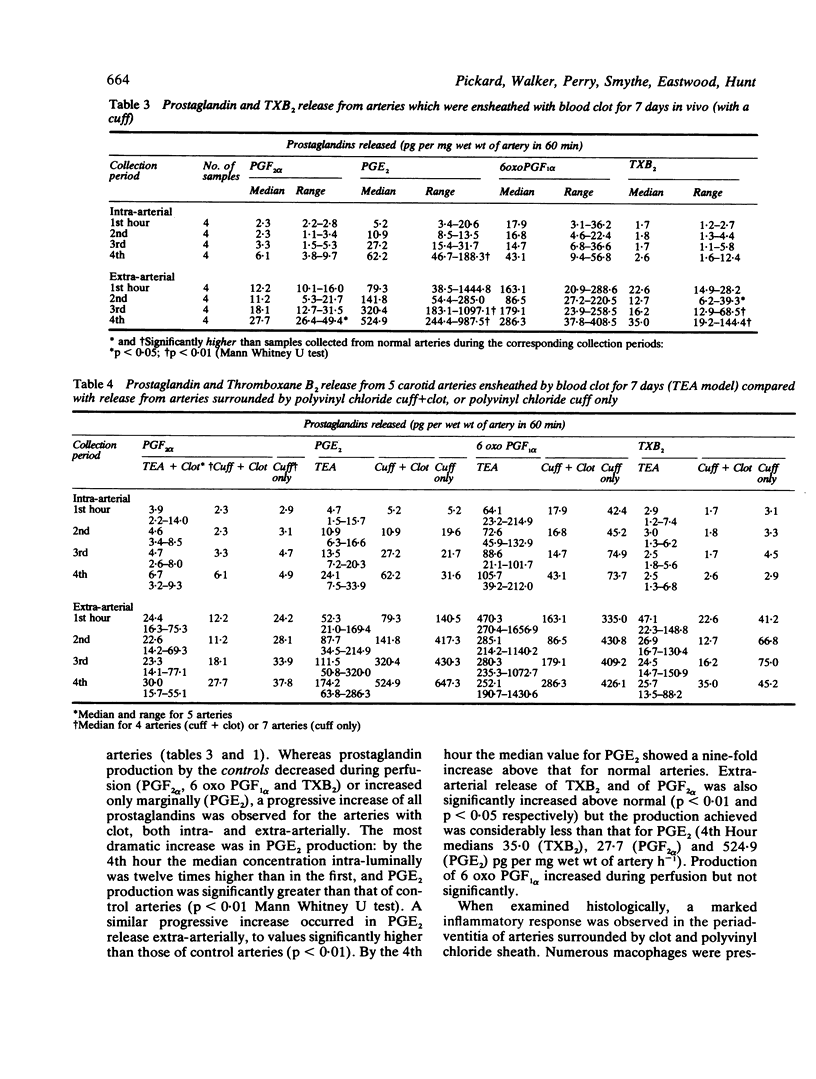Abstract
Cisternal and lumbar cerebrospinal fluid obtained some days following a subarachnoid haemorrhage contains abnormally large quantities of various prostanoids; some may be partly the result of abnormal production by the cerebral arteries. The extra-arterial and intra-arterial production of 6 oxo PGF1 alpha (prostacyclin metabolite), PGE2, PGF2 alpha and TXB2 were measured in perfused rabbit common carotid arteries taken both from normal rabbits and from rabbits in which the arteries had been ensheathed by blood clot in vivo for 7 days using two techniques. Prostaglandin production by control arteries was highest during the first hour of perfusion but declined or increased marginally (PGE2) during the succeeding three hours. Arteries exposed to a periarterial haematoma for 7 days produced prostaglandins at a high rate throughout the 4 hours of study, and there was a progressive and marked increase in PGE2 production. The disproportionate increase in the cerebral vasoconstrictor PGE2 may reflect the inflammatory response which occurred in the adventitia of the vessels. Increased prostanoid production by cerebral arteries probably does contribute to the increased levels in CSF after subarachnoid haemorrhage.
Full text
PDF






Selected References
These references are in PubMed. This may not be the complete list of references from this article.
- Baenziger N. L., Becherer P. R., Majerus P. W. Characterization of prostacyclin synthesis in cultured human arterial smooth muscle cells, venous endothelial cells and skin fibroblasts. Cell. 1979 Apr;16(4):967–974. doi: 10.1016/0092-8674(79)90111-9. [DOI] [PubMed] [Google Scholar]
- Bell B. A., Kendall B. E., Symon L. Computed tomography in aneurysmal subarachnoid haemorrhage. J Neurol Neurosurg Psychiatry. 1980 Jun;43(6):522–524. doi: 10.1136/jnnp.43.6.522. [DOI] [PMC free article] [PubMed] [Google Scholar]
- Clower B. R., Smith R. R., Haining J. L., Lockard J. Constrictive endarteropathy following experimental subarachnoid hemorrhage. Stroke. 1981 Jul-Aug;12(4):501–508. doi: 10.1161/01.str.12.4.501. [DOI] [PubMed] [Google Scholar]
- Fantone J. C., Ward P. A. Role of oxygen-derived free radicals and metabolites in leukocyte-dependent inflammatory reactions. Am J Pathol. 1982 Jun;107(3):395–418. [PMC free article] [PubMed] [Google Scholar]
- Fisher C. M., Kistler J. P., Davis J. M. Relation of cerebral vasospasm to subarachnoid hemorrhage visualized by computerized tomographic scanning. Neurosurgery. 1980 Jan;6(1):1–9. doi: 10.1227/00006123-198001000-00001. [DOI] [PubMed] [Google Scholar]
- Hsueh W., Kuhn C., 3rd, Needleman P. Relationship of prostaglandin secretion by rabbit alveolar macrophages to phagocytosis and lysosomal enzyme release. Biochem J. 1979 Nov 15;184(2):345–354. doi: 10.1042/bj1840345. [DOI] [PMC free article] [PubMed] [Google Scholar]
- Korn J. H. Fibroblast prostaglandin E2 synthesis. Persistence of an abnormal phenotype after short-term exposure to mononuclear cell products. J Clin Invest. 1983 May;71(5):1240–1246. doi: 10.1172/JCI110873. [DOI] [PMC free article] [PubMed] [Google Scholar]
- Kunkel S. L., Kaercher K., Plewa M., Fantone J. C., Ward P. A. Production of cyclooxygenase products and superoxide anion by macrophages in response to chemotactic factors. Prostaglandins. 1982 Dec;24(6):789–799. doi: 10.1016/0090-6980(82)90059-4. [DOI] [PubMed] [Google Scholar]
- Larrue J., Leroux C., Daret D., Bricaud H. Decreased prostaglandin production in cultured smooth muscle cells from atherosclerotic rabbit aorta. Biochim Biophys Acta. 1982 Mar 12;710(3):257–263. doi: 10.1016/0005-2760(82)90107-2. [DOI] [PubMed] [Google Scholar]
- Moncada S., Herman A. G., Higgs E. A., Vane J. R. Differential formation of prostacyclin (PGX or PGI2) by layers of the arterial wall. An explanation for the anti-thrombotic properties of vascular endothelium. Thromb Res. 1977 Sep;11(3):323–344. doi: 10.1016/0049-3848(77)90185-2. [DOI] [PubMed] [Google Scholar]
- Nishikawa K., Morrison A., Needleman P. Exaggerated prostaglandin biosynthesis and its influence on renal resistance in the isolated hydronephrotic rabbit kidney. J Clin Invest. 1977 Jun;59(6):1143–1150. doi: 10.1172/JCI108738. [DOI] [PMC free article] [PubMed] [Google Scholar]
- Okegawa T., Jonas P. E., DeSchryver K., Kawasaki A., Needleman P. Metabolic and cellular alterations underlying the exaggerated renal prostaglandin and thromboxane synthesis in ureter obstruction in rabbits. Inflammatory response involving fibroblasts and mononuclear cells. J Clin Invest. 1983 Jan;71(1):81–90. doi: 10.1172/JCI110754. [DOI] [PMC free article] [PubMed] [Google Scholar]
- Pickard J. D. Role of prostaglandins and arachidonic acid derivatives in the coupling of cerebral blood flow to cerebral metabolism. J Cereb Blood Flow Metab. 1981;1(4):361–384. doi: 10.1038/jcbfm.1981.41. [DOI] [PubMed] [Google Scholar]
- Salzman P. M., Salmon J. A., Moncada S. Prostacyclin and thromboxane A2 synthesis by rabbit pulmonary artery. J Pharmacol Exp Ther. 1980 Oct;215(1):240–247. [PubMed] [Google Scholar]
- Snider M. E., Fertel R. H., Zwilling B. S. Production of arachidonic acid metabolites by operationally defined macrophage subsets. Prostaglandins. 1983 Apr;25(4):491–501. doi: 10.1016/0090-6980(83)90021-7. [DOI] [PubMed] [Google Scholar]
- Stachura J., Kaluza J. Influence of prostaglandin on actinomycin C-induced degeneration of embryonal neuroectodermal tissue. Prostaglandins. 1982 Sep;24(3):433–440. doi: 10.1016/0090-6980(82)90169-1. [DOI] [PubMed] [Google Scholar]
- Walker V., Pickard J. D., Smythe P., Eastwood S., Perry S. Effects of subarachnoid haemorrhage on intracranial prostaglandins. J Neurol Neurosurg Psychiatry. 1983 Feb;46(2):119–125. doi: 10.1136/jnnp.46.2.119. [DOI] [PMC free article] [PubMed] [Google Scholar]
- Yarger W. E., Schocken D. D., Harris R. H. Obstructive nephropathy in the rat: possible roles for the renin-angiotensin system, prostaglandins, and thromboxanes in postobstructive renal function. J Clin Invest. 1980 Feb;65(2):400–412. doi: 10.1172/JCI109683. [DOI] [PMC free article] [PubMed] [Google Scholar]


